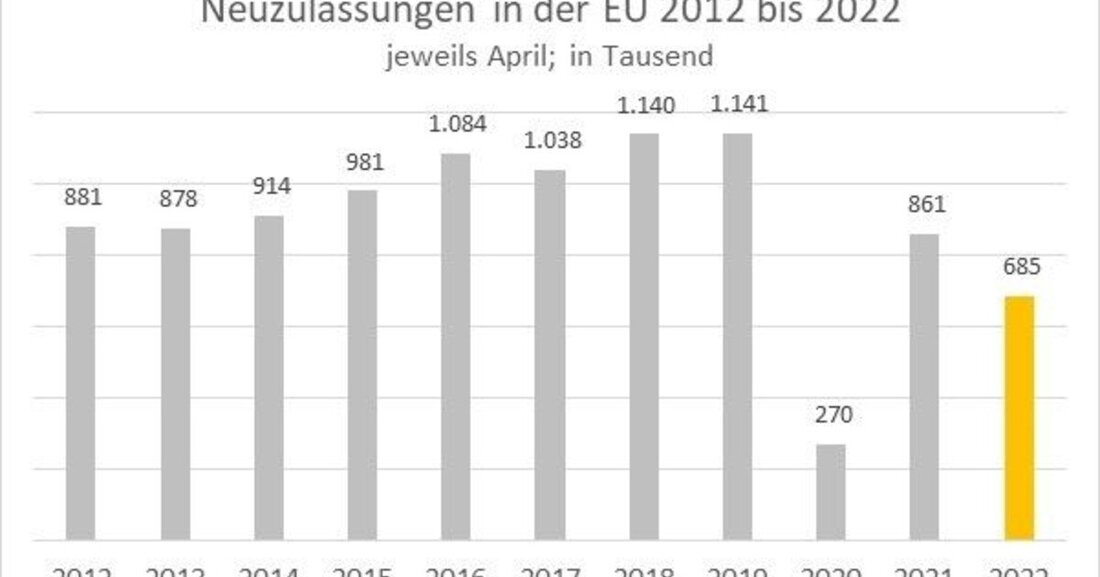The new car market remains in crisis mode
New car registrations in the EU fell by 21 percent in April and are now 40 percent below the 2019 level.

The new car market remains in crisis mode
The European new car market continues to shrink: In April, new car registrations in the EU fell by 21 percent compared to the same month last year. Compared to the pre-pandemic level (April 2019), there is even a decrease of 40 percent. Fewer cars were sold in the EU only in April 2020, at the height of the first Corona wave. In Austria, new registrations fell by 27 percent compared to the previous year. Compared to pre-pandemic levels, there is a decrease of 49 percent.
In addition to the chip crisis that has been going on for months, the consequences of the war in Ukraine and the lack of important supplier parts had an impact again in April, said Axel Preiss, Head of Advanced Manufacturing & Mobility at EY: "Important intermediate products and raw materials are still in short supply, and the significant bottlenecks in semiconductors in particular are causing problems for manufacturers. New corona lockdowns in China are putting additional pressure on global supply chains. The new car market is still on the brakes, which is why the ability to deliver will probably also be affected "There will be little improvement in the coming months. New cars will only be available to a limited extent, prices will remain high and manufacturers will continue to concentrate on producing high-margin vehicles."
Added to this is the economic slowdown, says Preiss: "Rising inflation, falling purchasing power and companies' limited willingness to invest could have an impact on demand for new cars in the medium term. But there is no sign of this yet - the order books are still full."
Since the further course of the war in Ukraine as well as the economic development and the availability of semiconductors are currently impossible or difficult to predict, all forecasts are subject to great uncertainty, says Preiss. However, a decline in new registrations in the EU of around ten percent compared to the previous year seems realistic at the moment, says Preiss: “2022 could bring a new historic low for the EU new car market.”
The crisis in the supply of important supplier parts is now also slowing down sales of electrified new cars: Sales of electric cars in the five largest markets in Western Europe (Germany, Great Britain, France, Italy and Spain) rose by only eight percent in April compared to the same month last year, after rising by 31 percent in March. In several countries - Germany, Austria and Italy - new registrations of purely electric cars even fell, in Austria by 23 percent.
The growth momentum in many markets for plug-in hybrids was particularly slowed down. Their sales fell by 16 percent in the top 5 markets in April and by 17 percent in Austria. Of the top five markets, only Spain showed an increase in sales of plug-in hybrids.
"Sales of electrified new cars are still developing better than combustion engines. But the chip crisis has long since caught up with the electric segment. If corresponding vehicles were available, the sales result would also be significantly better," says Preiss.
The market share of electrified new cars (electric and plug-in hybrids together) rose from 14.4 to 17.5 percent in the top 5 markets in April compared to the same month last year, and from 16.7 to 18.0 percent in Austria.
In April, Germany had the highest market share of electrified new cars among the top five markets in Western Europe at 24.3 percent. In Switzerland and France the market share was 21.5 and 21.1 percent, respectively.
In April, Switzerland reported the highest market share for purely electric cars (13.3%); in Germany, 12.3 percent of all new cars were electric cars. Plug-in hybrids remain the most popular in Germany: the market share here was 12.0 percent. This is followed by France (9.4%).

 Suche
Suche
 Mein Konto
Mein Konto